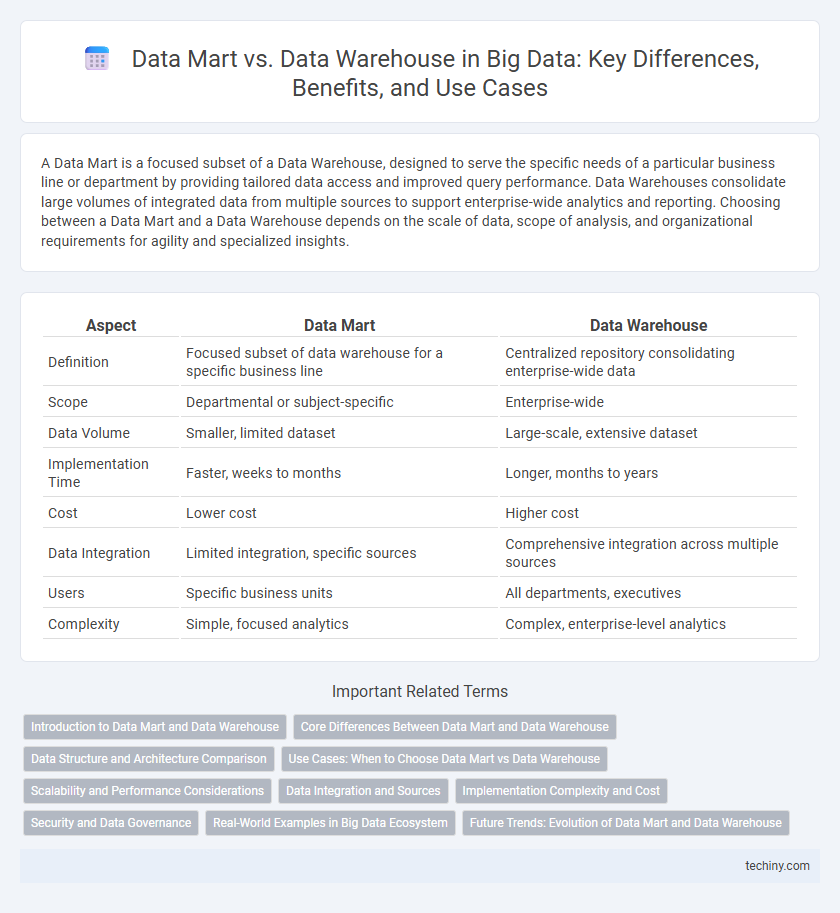A Data Mart is a focused subset of a Data Warehouse, designed to serve the specific needs of a particular business line or department by providing tailored data access and improved query performance. Data Warehouses consolidate large volumes of integrated data from multiple sources to support enterprise-wide analytics and reporting. Choosing between a Data Mart and a Data Warehouse depends on the scale of data, scope of analysis, and organizational requirements for agility and specialized insights.
Table of Comparison
| Aspect | Data Mart | Data Warehouse |
|---|---|---|
| Definition | Focused subset of data warehouse for a specific business line | Centralized repository consolidating enterprise-wide data |
| Scope | Departmental or subject-specific | Enterprise-wide |
| Data Volume | Smaller, limited dataset | Large-scale, extensive dataset |
| Implementation Time | Faster, weeks to months | Longer, months to years |
| Cost | Lower cost | Higher cost |
| Data Integration | Limited integration, specific sources | Comprehensive integration across multiple sources |
| Users | Specific business units | All departments, executives |
| Complexity | Simple, focused analytics | Complex, enterprise-level analytics |
Introduction to Data Mart and Data Warehouse
Data Mart is a focused subset of a Data Warehouse designed to serve specific business lines or departments, offering faster query performance and simplified data access. Data Warehouse aggregates and integrates vast amounts of enterprise-wide data from multiple sources, enabling comprehensive analysis and decision-making. Both Data Mart and Data Warehouse play essential roles in efficient big data management and analytics architecture.
Core Differences Between Data Mart and Data Warehouse
Data marts are specialized subsets of data warehouses that focus on specific business lines or departments, enabling faster query performance and targeted analysis. Data warehouses aggregate comprehensive organizational data from multiple sources, offering a centralized repository with high storage capacity and complex data integration. Core differences include scope, size, data granularity, and purpose, where data marts provide subject-specific, smaller-scale data, while data warehouses deliver enterprise-wide, detailed datasets for strategic decision-making.
Data Structure and Architecture Comparison
Data marts feature a focused data structure tailored to specific business lines or departments, often sourcing data directly from operational systems or a data warehouse. Data warehouses utilize a comprehensive, enterprise-wide architecture integrating diverse datasets into a centralized repository with a normalized or dimensional schema. This architectural difference leads data marts to offer faster query performance for specialized analysis, whereas data warehouses support extensive, cross-functional data analytics and reporting.
Use Cases: When to Choose Data Mart vs Data Warehouse
Data marts are ideal for department-specific analytics where quick access to targeted data enhances decision-making, such as sales or marketing teams needing focused insights. Data warehouses suit enterprise-wide data integration, supporting complex queries and comprehensive reporting across multiple business functions. Selecting between a data mart and data warehouse depends on organizational scope, data volume, and the granularity required for analytics.
Scalability and Performance Considerations
Data marts offer focused, subject-specific data storage, enabling faster query performance by limiting data scope, which improves scalability for departmental needs. Data warehouses handle vast volumes of enterprise-wide data with scalable architectures designed for complex analytics but may experience slower query response times due to broader data integration. Optimizing performance in data warehouses requires robust indexing and partitioning strategies, while data marts benefit from streamlined schemas tailored to specific business functions.
Data Integration and Sources
Data marts consolidate data from specific sources or departments, enabling focused data integration with streamlined access to relevant datasets. Data warehouses aggregate data from multiple diverse sources across an entire organization, providing comprehensive integration that supports enterprise-wide analytics. Effective data integration in data warehouses involves combining structured and unstructured data from various operational systems, improving consistency and reliability for analysis.
Implementation Complexity and Cost
Data marts typically have lower implementation complexity and cost because they focus on specific business areas, allowing faster deployment with less resource investment. Data warehouses require more extensive integration, infrastructure, and maintenance, leading to higher costs and longer implementation timelines. Organizations often choose data marts for targeted analytics while relying on data warehouses for comprehensive, enterprise-wide data analysis.
Security and Data Governance
Data marts offer targeted security controls by limiting access to specific business units, enabling granular user permissions and reducing exposure of sensitive data compared to enterprise-wide data warehouses. Data warehouses incorporate comprehensive data governance frameworks, ensuring standardized policies, metadata management, and regulatory compliance across multiple datasets and sources. Combining robust governance in data warehouses with targeted security in data marts optimizes protection and control over organizational data assets.
Real-World Examples in Big Data Ecosystem
A Data Mart typically serves a specific business line or department, exemplified by Amazon's use of customer purchase data marts to optimize marketing campaigns, while a Data Warehouse consolidates extensive data across the organization, as seen in Walmart's centralized data warehouse managing inventory, sales, and supply chain information. In the Big Data ecosystem, Data Marts enable faster, targeted analytics by handling smaller, curated datasets, contrasting with data warehouses that support comprehensive, cross-functional business intelligence. Netflix employs both by maintaining a data warehouse for global user activity and separate data marts for regional content performance analytics, illustrating their complementary roles in large-scale data infrastructure.
Future Trends: Evolution of Data Mart and Data Warehouse
Data Marts and Data Warehouses are evolving with the integration of advanced analytics, artificial intelligence, and cloud-native architectures, enabling real-time data processing and enhanced scalability. The future trends indicate a shift towards hybrid models where Data Marts provide focused, subject-oriented insights while Data Warehouses serve as centralized repositories with comprehensive, enterprise-wide data consolidation. Increased adoption of automation and machine learning within these systems will drive smarter data management and more efficient decision-making processes.
Data Mart vs Data Warehouse Infographic

 techiny.com
techiny.com